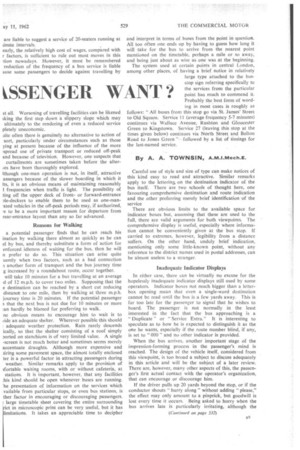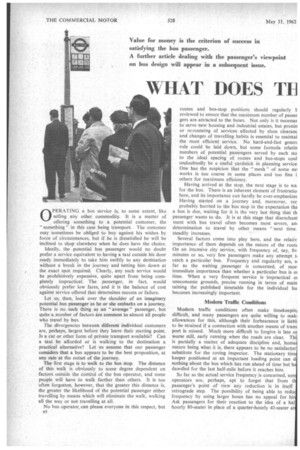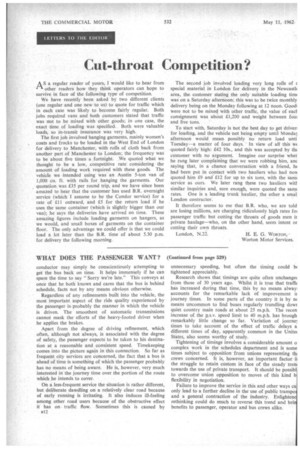SSENGER WANT?
Page 35

Page 34

Page 38

If you've noticed an error in this article please click here to report it so we can fix it.
OPERATING a bus service is, to some extent, like selling any other commodity. It is a matter of offering something to a potential customer, the " something " in this case being transport. The customer may sometimes be obliged to buy against his wishes by force of circumstances, but if he is dissatisfied he will be inclined to shop elsewhere when he does have the choice.
Ideally, the potential bus passenger would no doubt prefer a service equivalent to having a taxi outside his door ready immediately to take him swiftly to any destination without a break in the journey and setting him down at the exact spot required. Clearly, any such service would be prohibitively expensive, quite apart from being completely impractical. The passenger, in fact, would obviously prefer low fares, and it is the balance of cost against service offered that determines success or failure.
Let us, then, look over the shoulder of an imaginary potential bus passenger as he or she embarks on a journey. There is no such thing as an " average " passenger, but quite &number of factors are common to almost all people who travel by bus.
The divergencies between different individual customers are, perhaps, largest before they leave their starting point. Is a car or other form of private transport available? Can a taxi be afforded or is walking to the destination a practical alternative? Let us assume that our passenger considers that a bus appears to be the best proposition, at any rate at the outset of the journey.
The first stage is to walk to the bus stop. The distance of this walk is obviously to some degree dependent on factors outside the control of the bus operator, and some people will have to walk farther than others. It is too often forgotten, however, that the greater this distance is, the greater the likelihood of the potential passenger either travelling by means which will eliminate the walk, walking all the way or not travelling at all.
No bus operator, can please everyone in this respect, but Hs routes and bus-stop positions should regularly reviewed to ensure that the maximum number of passer gers are attracted to the buses. Not only is it necessar to serve new housing and industrial estates, but prunin or re-routeing of services affected by slum clearanc and changes of travelling habits is essential to maintai the most efficient service. No hard-and-fast genen rule could be laid down, but some formula relatin numbers of potential passengers served by each sto to the ideal spacing of routes and bus-stops coul undoubtedly be a useful yardstick in planning service One has the suspicion that the " mesh " of some nei works is too coarse in some places and too fine i others for maximum efficiency.
Having arrived at the stop, the next stage is to wa for the bus. There is an inherent element of frustratio here, and its importance can hardly be over-emphasize( Having started on a journey and, moreover, ver probably hurried to the bus stop in the expectation du a bus is due, waiting for it is the very last thing that th passenger wants to do. It is at this stage that disenchant ment with bus travel often becomes most severe, an determination to travel by other means "next time steadily increases.
Several factors come into play here, and the relativ importance of them depends on the nature of the routt On an intensive city service, with frequency of, say, fly minutes or so, very few passengers make any attempt to catch a particular bus. Frequency and regularity are, so far as the waiting .passenger is concerned, of mor immediate importance than whether a particular bus is oi time. When a very frequent service is impractical oi uneconomic grounds, precise running in terms of main taming the published timetable for the individual bu becomes increasingly important.
Modern Traffic Conditions
Modern traffic conditions often make timekeepin difficult, and many passengers are quite willing to mato allowances for this, although their forbearance is liablo to be strained if a connection with another means of trans port is missed. Much more difficult to forgive is late o worse still, early running when the roads are clear. Thi is partially a matter of adequate discipline and, huma nature being what it is, there appears to be no satisfacto substitute for the roving inspector. The stationary tim keeper positioned at an important loading point can d nothing about the bus which has run ahead of time but h dawdled for the last half-mile before it reaches him.
So far as the actual service frequency is concerned, so operators are, perhaps, apt to forget that from t passenger's point of' view any reduction is in itself retrograde step. The possibility of being able to redu frequency by using larger buses has no appeal for hi Ask passengers for their reaction to the idea of a hal hourly 80-seater in place of a quarter-hourly 40-seater a are liable to suggest a service of 20-seaters running at imute intervals.
early, the relatively high cost of wages, compared with r factors, is sufficient to rule out most moves in this ;tion nowadays. However, it must be remembered reduction of the frequency of a bus service is liable ause some passengers to decide against travelling by
it all. Worsening of travelling facilities can be likened tking the first step down a slippery slope which may ultimately to the rendering of even a reduced service pletely uneconomic.
aite often there is genuinely no alternative to action of sort, particularly under circumstances such as those ying at present because of the influence of the more spread use of private transport or reduced off-peak and because of television. However, one suspects that curtailments are sometimes taken before the alter/es have been thoroughly explored.
lthough one-man operation is not, in itself, attractive assengers because of the slower boarding in which it Its, it is an obvious means of maintaining reasonably I frequencies when traffic is light. The possibility of ting off the upper deck of frontor forward-entrance 31e-deckers to enable them to be used as one-manated vehicles in the off-peak periods may, if authorized, ,e to be a more important reason for departure from rear-entrance layout than any so far advanced.
Reasons for Walking a potential passenger finds that he can reach his ination by walking there almost as quickly as he can el by bus, and thereby substitute a form of action for enforced idleness of waiting for the bus, then he will n prefer to do so. This situation can arise quite uently when two factors, such as a bad connection
another form of transport and the bus journey time g increased by a roundabout route, occur together. will take 10 minutes for a bus travelling at an average .43 of 12 m.p.h. to cover two miles. Supposing that the e destination can be reached by a short cut reducing distance to one mile, then by walking at three m.p.h. journey time is 20 minutes. If the potential passenger
s that the next bus is not due for 10 minutes or more an hardly be blamed for preferring to walk.
ne obvious means to encourage him to wait is to vide an adequate shelter. Wherever possible this should adequate weather protection. Rain rarely descends ically, so that the shelter consisting of a roof simply ported on stanchions is of very limited value. A single -screen is not much better and sometimes seems merely accentuate draughts. Although more expensive and tiring some pavement space, the almost totally enclosed ter is a powerful factor in attracting passengers during weather. Similar remarks apply to the provision of tfortable waiting rooms, with or without cafeteria, at stations. It is important, however, that any facilities his kind should be open whenever buses are running. he presentation of information on the services which .vailable from particular stops, or even bus stations, is ther factor in encouraging or discouraging passengers. ; large timetable sheet covering the entire surrounding 'ct in microscopic print can be very useful, but it has imitations. It takes an appreciable time to decipher
and interpret in terms of buses from the point in question. All too often one ends up by _having to guess how long it will take for the bus to arrive from the nearest point mentioned on the timetable, perhaps a mile or so away, and being just about as wise as one was at the beginning.
The system used at certain points in central London, among other places, of having a brief notice in relatively large type attached to the busstop sign referring specifically to the services from the particular point has much to commend it. Probably the best form of wording in most cases is roughly as follows: ".All buses from this stop go via St. James' Street to Old Square. Service II (average frequency 5-7 minutes) continues via Wallace Avenue, Rushton and Gloucester Green to Kingstown. Service 27 (leaving this stop at the times given below) continues via North Street and Bolton Road to Jones Green "followed by a list of timings for the last-named service.
By A. A. TOWNSIN, A.M.I.Mech.E.
Careful use of style and size of type can make notices of this kind easy to read and attractive. Similar remarks apply to the lettering, on the destination indicator of the bus itself. There are two schools of thought here, one favouring comprehensive destination and route indication and the other preferring merely brief identification -of the service There are obvious limits to the available space for indicator boxes but, assuming that these are used to the full, there are valid arguments for both viewpoints. The comprehensive display is useful, especially where information cannot be conveniently given at the bus stop. If carried to extremes, however, legibility from a distance suffers. On the other hand, unduly brief indication, mentioning only some little-known point, without any reference to the district names used in postal addresses, can be almost useless to a stranger.
Inadequate Indicator Displays
In either case, there can be virtually no excuse for the hopelessly inadequate indicator displays still used by some operators. Indicator boxes not much bigger than a letterbox opening mean that even a single-word destination cannot be read until the bus is a few yards away. This is far too late for the passenger to signal that he wishes to board. The passenger is not normally in the least interested in the fact that the bus approaching is a " Duplicate " or "Service Extra." It is interesting to speculate as to how he is expected to distinguish it as the one he wants, especially if the route number blind, if any, is set to " 000 " and no other indicator is provided.
When the bus arrives, another important stage of the impression-forming process in the passenger's mind is reached. The design of the vehicle itself, considered from this viewpoint, is too broad a subject to discuss adequately in this article and will be the subject of a later review. There are, however, many other aspects of this, the passenger's first actual contact with the operator's organization, that can encourage or discourage him.
If the driver pulls up 20 yards beyond the stop, or if the conductor shouts "hurry along" without adding "please," the effect may only amount to a pinprick, but goodwill is lost every time it occurs. Being asked to hurry when the bus arrives late is particularly irritating, although the
conductor may simply be conscientiously attempting to get the bus back on time. It helps immensely if he can spare the time to say "Sorry we're late." This conveys at once that he both knows and cares that the bus is behind schedule, facts not by any means obvious otherwise.
Regardless of any refinements built into the vehicle, the most important aspect of the ride quality experienced by the passenger is probably the manner in which the vehicle is driven. The smoothest of automatic transmissions cannot mask the efforts of the heavy-footed driver when he applies the brakes.
Apart from the degree of driving refinement, which often, although not always, is associated with the degree of safety, the passenger expects to be taken to his destination at a reasonable and consistent speed. Timekeeping comes into the picture again in this connection. So far as frequent city services are concerned, the fact that a bus is ahead of time is something of which the passenger probably has no means of being aware. He is, however, very much interested in the journey time over the portion of the route which he intends to cover.
On a less-frequent service the situation is rather different, but deliberate dawdling on a relatively clear road because of early running is irritating. It also induces ill-feeling among other road users because of the obstructive effect it has on traffic flow. Sometimes this is caused by unnecessary speeding, but often the timing could IN tightened appreciably.
Research shows that timings are quite often unchange< from those of 30 years ago. Whilst it is true that traffi( has increased during that time, this by no means alway accounts for the remarkable lack of improvement it journey times. In some parts of the country it is by tu means uncommon to find buses regularly trundling dowl quiet country main roads at about 25 m.p.h. The recen increase of the p.s.v. speed limit to 40 m.p.h. has brough remarkably little change so far. Variation of journel times to take account of the effect of traffic delays a different times of day, apparently common in the Unite( States, also seems worthy of study.
Tightening of timings involves a considerable amount o complex work in the schedules department and is some times subject to opposition from unions representing thl crews concerned. It is, however, an important factor ii the struggle to retain custom in face of the steady trem towards the use of private transport. It should be possibl to overcome union opposition to moves of this kind b flexibility in negotiation.
Failure to improve the service in this and other ways ca only lead to a further decline in the use of public transpo and a general contraction of the industry. Enlightene rethinking could do much to reverse this trend and bri benefits to passenger, operator and bus crews alike.




































































































